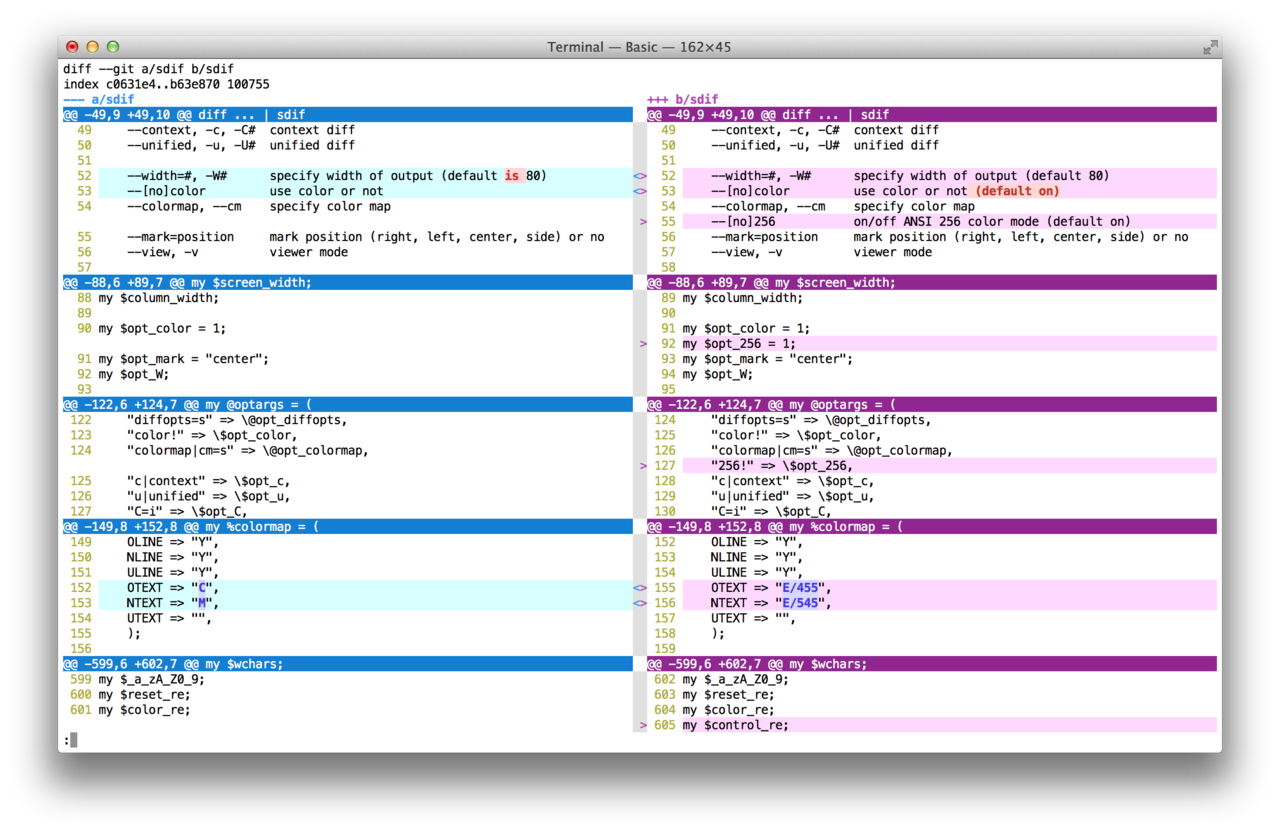cdif / sdif / watchdiff now runs on Linux
OS X でしか使っていなかったのですが、Linux で実行してみたら使えなかったので修正しました。
- 端末の幅を取得するのに stty を使っていたが、仕様の違いがあるので tput を使うように変更
- Text::Glob は標準モジュールだと思っていたが違ったので使わないように変更
また、一時ファイルの取り扱いが変わっています。
- 従来は /tmp にファイルを作成して使用後に削除していた
- それを IO::File::new_tmpfile を使うように変更
- これだとファイルをオープンすると同時に unlink するので削除する必要がない
- そのため異常終了してもファイルが残らない
- diff コマンドに与えるパスは /dev/fd/ を使うように変更
追記
会社の FreeBSD で試してみると /dev/fd/3, /dev/fd/4 が開けないといいますね。 CLOSE ON EXEC の解除ができていないのでは疑ったのですが、そうではなくてファイルシステムの問題のようです。 マニュアルを見ると devfs(5) は 0, 1, 2 しか提供しないので、fdescfs(5) を使えと書いてあります。 こういう場合は設定を変えてくださいという方針でいいんでしょうかね。
追記2
sdif, cdif, watchdiff を統合して sdif-tools というリポジトリで管理するようになっています。
CPAN にもリリースしたので、cpanminus でインストールできます。
$ cpanm App::sdif
watchdiff -- cdif wrapper for monitoring command result
最近、gitbub で iij/watch というコマンドがひっそりと公開されました。 管理者の yasuoka 君は以前の同僚で、このコマンドは2000年に一緒の部署で働いていた時にみんなで作ったものですね。 元々は BSD/OS に watch というコマンドがあって、ちょっと拡張しようといじってたら結局作り直しちゃったやつです。 ずっと社内で使っていたものを公開したのには何か理由があるようですが、詳しいことは知りません。
このコマンドの機能は、指定したコマンドを定期的(デフォルトでは2秒おき)に実行して結果を画面に出すだけです。 少し工夫してあって、変更された部分を反転できるようになってたり、 出力が画面に入り切らない時には、スクロールして見ることもできます。
たいしたものではないけど意外と便利で、今でもたまに使ったりします。 たとえば、こんな感じ。
- WiFi の電波が取れないなー、なんでかな〜てな時
watch ifconfig -a
- やっべー、ディスクぎりぎりだよ、足りるかあ〜てな時
watch df
- ネットワーク調子悪いなあ、なんか起こってるのかしらん?てな時
まあ、これでもいいんだけど、反転だけではどうも色気がないんですね。 ncurses は色にも対応しているようなので、そういうの使うという手もあるのだけど、変更部分を調べる仕組みが単純に作ってあるので、行が増えたり減ったりすると途端にお手上げなわけです。
だったら、せっかく cdif で色が出るようにしたんだから、それを使えばいいじゃんということで作ってみました。 こんな感じの画面が2秒おきに表示されると考えておくんなさい。 cdif の変更点は、単に余計な部分を表示しないようにしただけです。 あ、実装言語は Perl ですよ。

似たようなツールはほかにもたくさんありそうですけどね。 watchdiff は、デフォルトでは垂れ流しモードなので、画面を書き換えずにスクロールしていきます。 最近はマルチウィンドウ環境が前提なので、その方が案外使いやすい場面も多いのではないかと思います。
しかし、en0 と連動する p2p0 ってインタフェースは一体何なんでしょうか? などという今まで気にもしなかかったことも、ビジュアル化することで気がついたりするわけです。 どうも、AirDrop と関係があるくさいです。
ちなみに watch コマンドで同じような画面を見ると、こうなります。 これでは、どこが変わったのかさっぱりわかりません。 ubuntu にも watch コマンドがあるらしいですが、それだとどう見えるのか気になるところです。

即席なので実装は粗粗、マニュアルテキトー。 特に端末制御周りは手抜きで、OS X 以外で動くかどうかはかなり怪しいです。 何かあったら github の issues でもなんでも適当にどうぞ。
NAME
watchdiff - repeat command and watch the differences
SYNOPSIS
watchdiff option -- command
Options:
--refresh=# refresh screen count (default 0)
--interval=# interval time between execution in second (default 2)
--count=# command repeat count (default 1000)
--[no]date show date at the beginning (default on)
--[no]silent do not show same result (default off)
--[no]newline print newline after command result (default on)
--exec set executing commands
--diff=command diff command used to compare result
Example:
watchdiff df
watchdiff --silent df
watchdiff --refresh 5 --noclear -- df
watchdiff --refresh 1 -- netstat -s -p ip
watchdiff --refresh 1 --exec uptime --exec iostat --exec df
watchdiff -s --refresh 1 --diff 'sdif --cdif -U100' -- netstat -sp ip
watchdiff --nodate --nonewline --count=18 --interval=10 date
INSTALL
cpanm App::sdif
AUTHOR
Kazumasa Utashiro
https://github.com/kaz-utashiro/sdif-tools
SEE ALSO
diff(1), cdif(1), sdif(1)
COPYRIGHT
Use and redistribution for ANY PURPOSE are granted as long as all copyright notices are retained. Redistribution with modification is allowed provided that you make your modified version obviously distinguishable from the original one. THIS SOFTWARE IS PROVIDED BY THE AUTHOR ``AS IS'' AND ANY EXPRESS OR IMPLIED WARRANTIES ARE DISCLAIMED.
ANSI 端末の216色カラーテーブル
あ、それから、なんとなく sdif に --colortable というオプションが入ってます。 こんなのね。
最初の列は横縞、2番目の列は縦縞に見えます。 3番目はどっちかなあという感じ。
RGB の値から輝度を計算するのには次の式を使います。 明るさに与える影響は、緑が6割もあるので、緑の変化がはっきり見えるんですね。
輝度 = 0.298912 * R + 0.586611 * G + 0.114478 * B
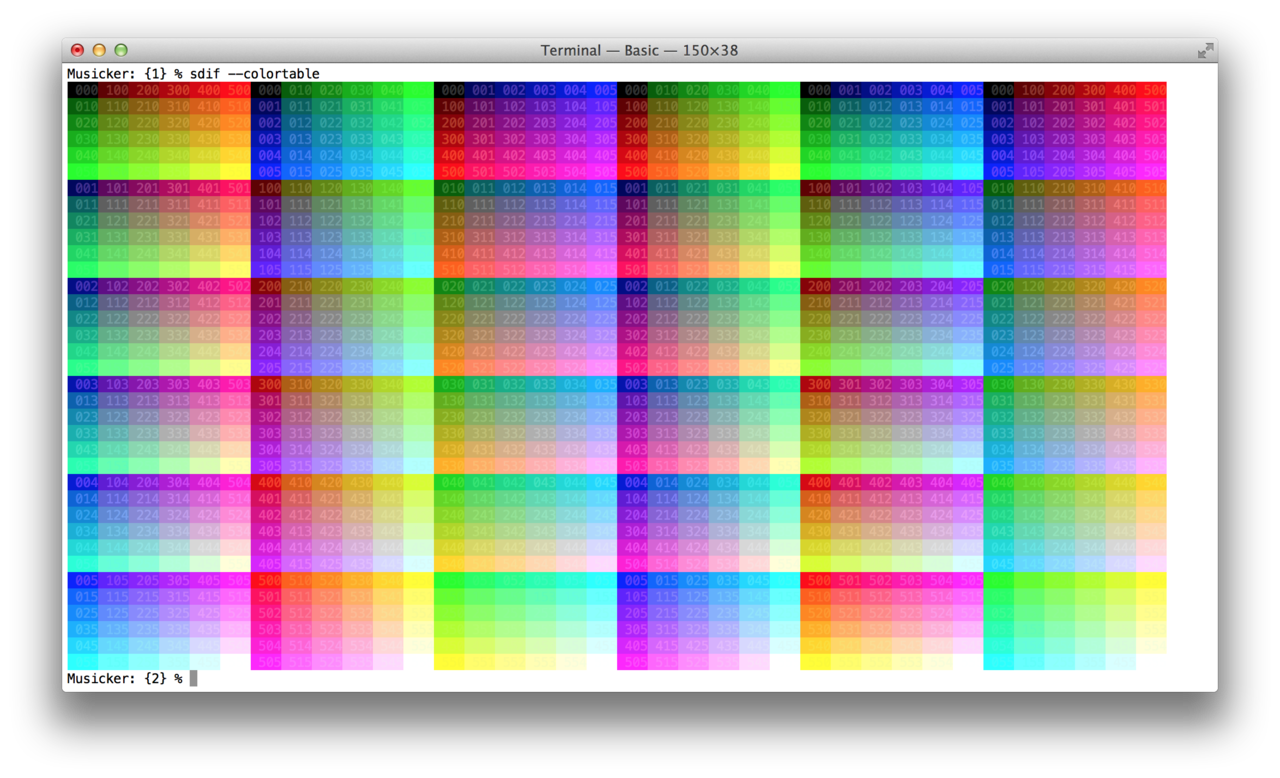
cdif v2.9 / sdif v2.6 Latin and Russian support
ラテン系の言語とロシア語に対応しました。 タイ語も処理は一応入れてみたけど、ちゃんと表示できません。 例文は質問サイトから拝借。
漢字の連続をひとつの単語として処理するのはやめました。 これで中国語もデフォルトのままで問題ありません。 日本語については若干振る舞いが変わりますが、それほど問題ではないと思うし、ちゃんと見たい時には --mecab オプションを使った方がいいです。
それから、変更部分の背景色を変更しました。 実際に使ってみると、左右が同じ色の方が比較しやすいのと、シアンやマジェンタに赤や青を乗せると判別しにくいからです。
Français / French
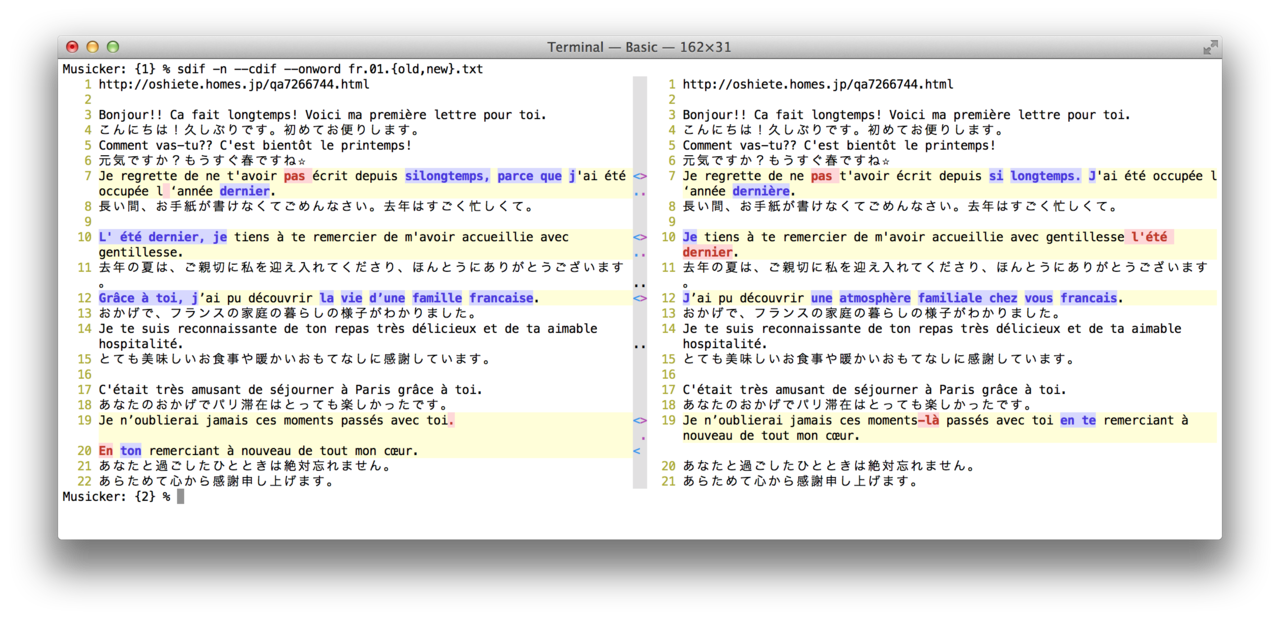
Deutsch / German

Русский / Russian
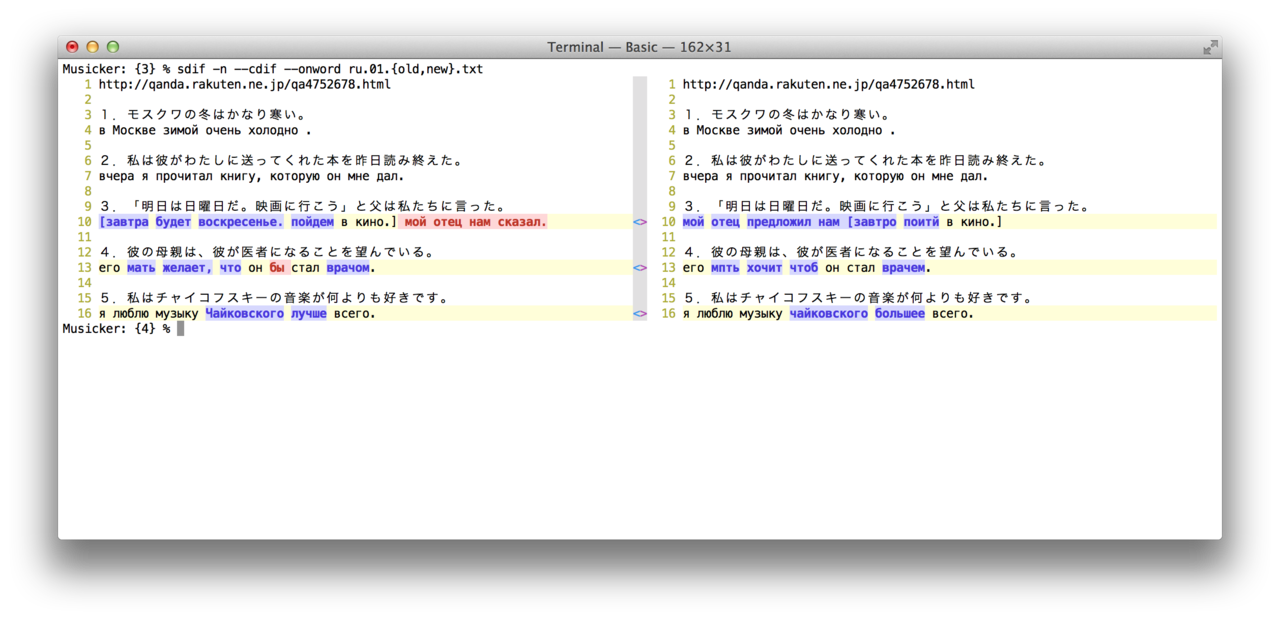
cdif/sdif でいろんな言語を試してみた / multi language trial
Korean
多分大丈夫だろうと思ってはいたが、韓国語はなんの問題もなく処理できる。
As expected, Korean is fine.
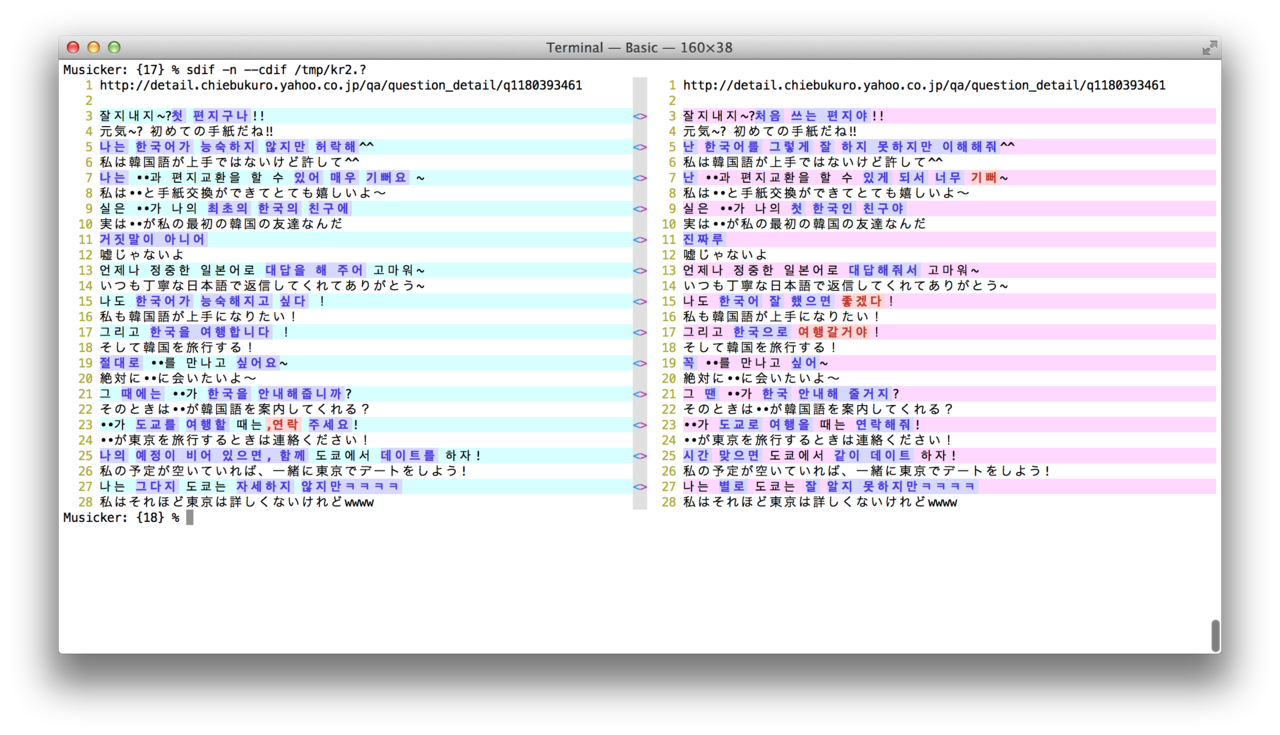
Chinese
中国語は、案の定漢字の連続を一単語として処理すると塩梅が悪い。 -B オプションをつけるとうまく行っているような気がする。
Chinese works ok with -B option for cdif.

Arabic
よもやと思ってアラビア語をやってみた。
Arabic doesn't work.
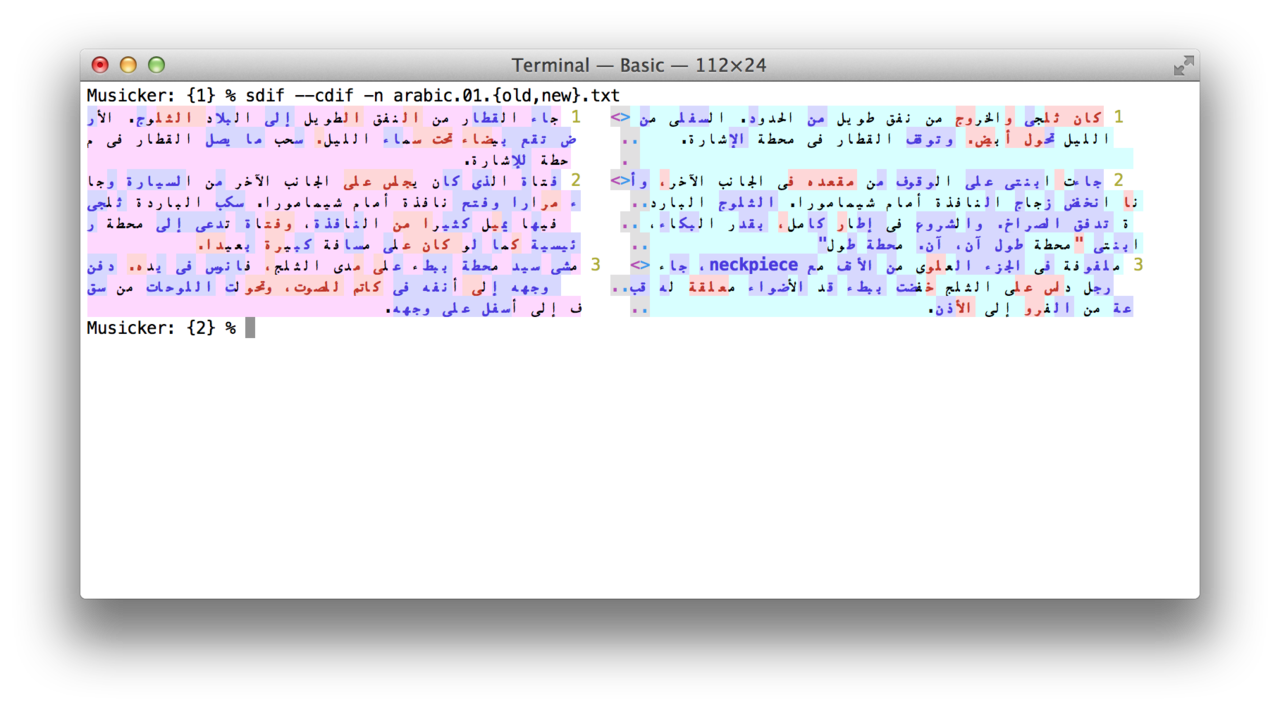
やっぱり駄目だったか...
そもそも、どうしてアラビア語の部分だけではなくて全体が左右反転してしまうのかとか、まったくメカニズムがわからない。
ちなみに、アラビア語はサンプルがみつからなかったので、雪国の冒頭部分の日本語と英訳を Google で翻訳したものである。
cdif/sdif 256色対応
sdif updated
Side-by-side / ANSI color / word context
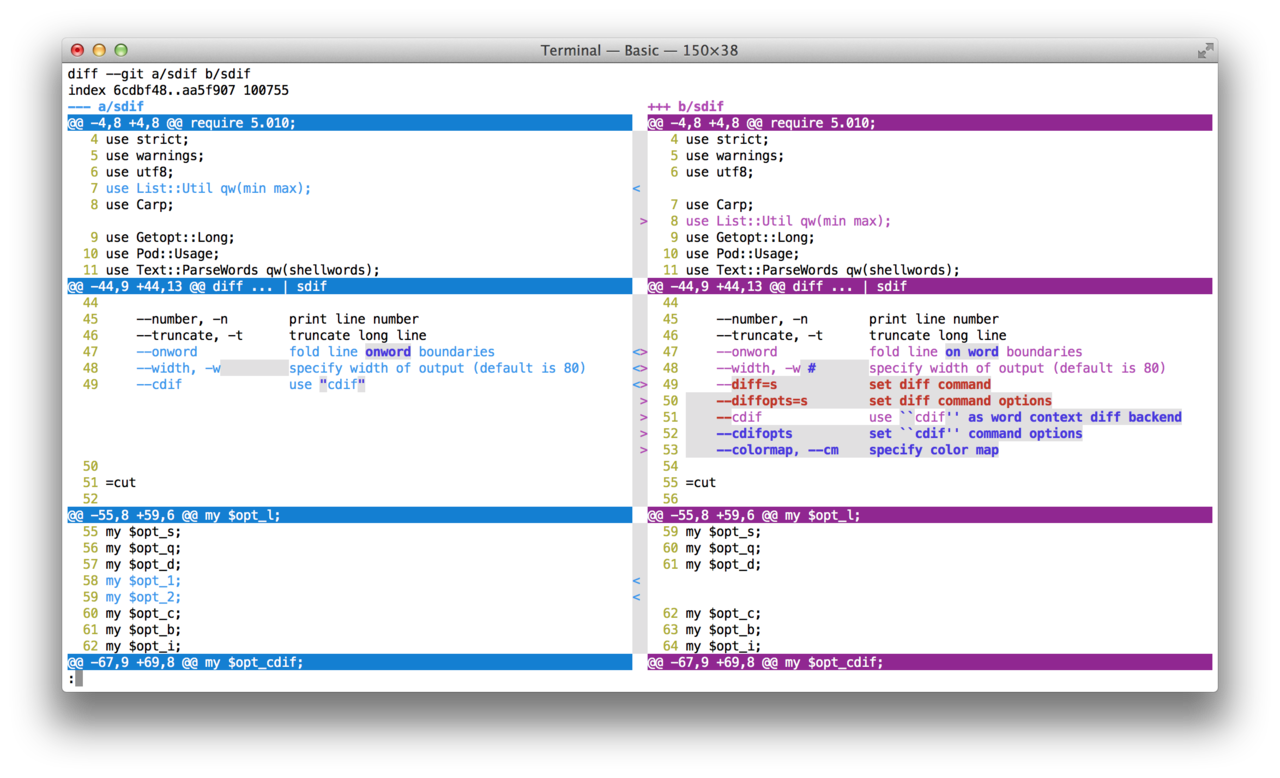
Unicode / Japanese
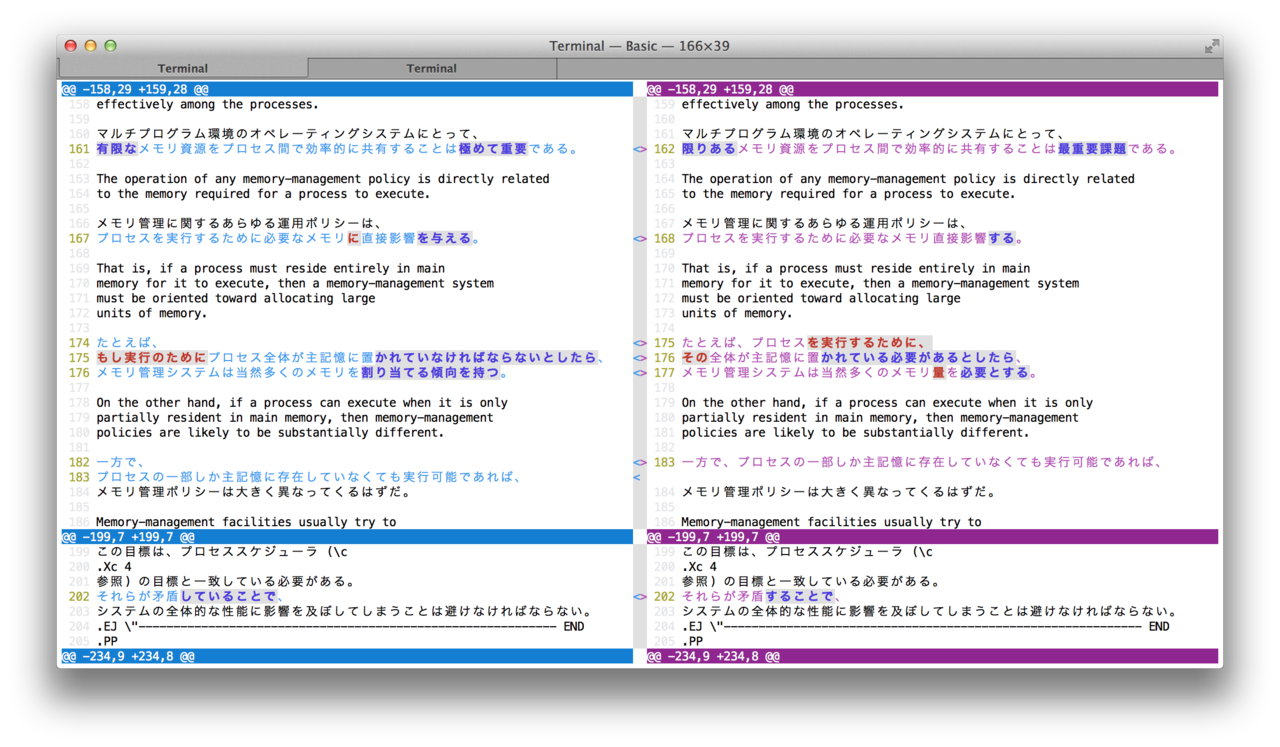
With --mecab morphology

NAME
sdif - side-by-side diff viewer for ANSI terminal
SYNOPSIS
sdif file_1 file_2
diff ... | sdif
--number, -n print line number
--digit=n set the line number digits (default 4)
--truncate, -t truncate long line
--onword fold line on word boundaries
--width, -w # specify width of output (default is 80)
--diff=s set diff command
--diffopts=s set diff command options
--[no]color use color or not
--colormap, --cm specify color map
--mark=position mark position (right, left, center, side) or no
--man display manual page
-c, -C# context diff
-u, -U# unified diff
--cdif use ``cdif'' as word context diff backend
--cdifopts set cdif command options
--mecab pass --mecab option to cdif
DESCRIPTION
sdif is inspired by System V sdiff(1) command. The basic feature of sdif is making a side-by-side listing of two different files. All contents of two files are listed on left and right sides. Center column is used to indicate how different those lines. No mark means no difference. Added, deleted and modified lines are marked with `<' and `>' character.
1 deleted <
2 same 1 same
3 changed <> 2 modified
4 same 3 same
> 4 added
It also reads and formats the output from diff command from standard input. Besides normal diff output, context diff -c and unified diff -u output will be handled properly.
Each lines can be displayed in different colors. Read --colormap section in ths manual for detail.
While sdif doesn't care about the contents of each modified lines, it can read the output from cdif command which show the word context differences of each lines. Option --cdif set the appropriate options for cdif. Set --nocc, --nomc options at least when invoking cdif manually. Option --notc is pereferable because text color can be handled by sdif.
Environment valuable SDIFOPTS is used to set default options.
OPTIONS
--w=width, -w
Use width as a width of output listing. Default width is 80. If the standard error is assinged to a terminal, the width is taken from it if possible.
--number, -n
Print line number on each lines.
--digit=n
Line number is diplayed in 4 digits by dafult. Use this option to change it.
-c, -Cn, -u, -Un
Passed through to the back-end diff command. Sdif can interpret the output from normal, context (diff -c) and unified diff (diff -u).
--truncate, -t
Truncate lines if they are longer than printing width.
--onword
Fold longs line at word boundaries.
--cdif
Use cdif command instead of normal diff command.
--cdifopts=option
Specify options for backend cdif command.
--mecab
Pass --mecab option to backend cdif command. Use --cdifopts to set other options.
--diff=command
Any command can be specified as a diff command to be used. Piping output to sdif is easier unless you want to get whole text.
--diffopts=option
Specify options for backend diff command.
--mark=position
Specify the position for mark. Choose from left, right, center, side or no. Default is center.
--[no]color
Use ANSI color escape sequence for output. Default is true.
--colormap=colormap, --cm=colormap
Basic colormap format is :
FIELD=COLORwhere the FIELD is one from these :
OLD NEW UNCHANGED --------- --------- --------- OCOMMAND NCOMMAND : Command line OFILE NFILE : File name OMARK NMARK UMARK : Mark OLINE NLINE ULINE : Line number OTEXT NTEXT UTEXT : TextYou can make multiple filelds same color joining them by = :
FIELD1=FIELD2=...=COLORAlso wildcard can be used for field name :
*CHANGE=BDwMultiple fields can be specified by repeating options
--cm FILED1=COLOR1 --cm FIELD2=COLOR2 ...or combined with comma (,) :
--cm FILED1=COLOR1,FIELD2=COLOR2, ...COLOR is combination of single character representing uppercase foreground color :
R Red G Green B Blue C Cyan M Magenta Y Yellow K Black W Whiteand corresponding lowercase background color :
r, g, b, c, m, y, k, wand other effects :
S Standout (reverse video) U Underline D Double-struck (boldface) F Flash (blink) E ExpandE is effective for command, file and text line. That line will be expanded to window width filling up by space characters. Left column is expanded always. You may want to use this to set background color for right column.
Defaults are :
OCOMMAND => "CSE" NCOMMAND => "MSE" OFILE => "CDE" NFILE => "MDE" OMARK => "Cw" NMARK => "Mw" UMARK => "w" OLINE => "Y" NLINE => "Y" ULINE => "Y" OTEXT => "C" NTEXT => "M" UTEXT => ""This is equivalent to :
sdif --cm 'OCOMMAND=CSE,NCOMMAND=MSE,OFILE=CDE,NFILE=MDE' \ --cm 'OMARK=Cw,NMARK=Mw,UMARK=w' \ --cm '*LINE=Y,OTEXT=C,NTEXT=M,UTEXT='Try next setting if you want to make modified section more visible.
sdif -n --cdif --cm '[ON]TEXT=wE,UMARK=,OMARK=C,NMARK=M'
AUTHOR
Kazumasa Utashiro
https://github.com/kaz-utashiro/
